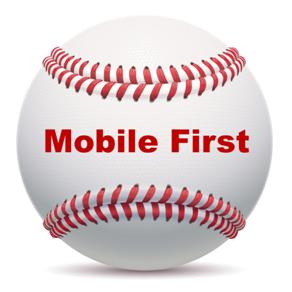In an insightful interview by the Wall Street Journal’s Walter Mossberg with Bob Bowman, MLB’s head of Advance Media, there are great lessons about how traditional entertainment businesses are navigating the digital space – especially mobile.
First, there’s an experimental aspect to what MLB has accomplished, led by the vision of MLB Commissioner Bud Selig who championed the idea of a digital division for his league. Here’s Bowman’s quote on vision and leadership:
“We started at a time when Internet was up and down, and no one knew it was going to work… I think we kind of worked in stealth mode for three or four years, and then emerged as the technology got better.”
So, there was none of the “We’re not going to invest in the Internet until we can monetize it” attitude that has permeated radio for the past couple of decades. Being proactive has been the secret behind MLB’s incredible success in the space. There was a realization they had the content and the fans. So if you get behind technology, it’s not a bad bet.
Second, there’s a realization that mobile is the thing. When Mossberg asks Bowman whether MLB has a “mobile first” philosophy, here’s his response:
“We’re big believers that this (mobile phone) screen is the first screen….this is the screen you look at 300 times a day….reality is the second screen; this is the first screen.”
And while he acknowledges that watching a real game in a real stadium is still the best way to experience watching your favorite team, there is no getting around the power and ubiquity of the smartphone. Even though the sport may compete with itself – fans who would rather watch a game on their phones, tablets, or TVs – there is no getting away from the reality of mobile’s hold on consumers.
Third, it’s about making the experience a great one. And yes, it’s time spent with the MLB app averages out to only 10 minutes a day.
MLB works relentlessly on its mobile presence, first and foremost – the User Experience and monetization. For the millions that have downloaded their app, they estimate that 10 minutes is about the average amount of time spent with their multi-purpose app.
That should sound familiar to radio people as 10 minutes is essentially the time of an average listening occasion in PPM. So how that experience comes together for the user – the fan – is at the heart of the matter for MLB. As Bowman points out, a consumer interfaces with lots of brands and companies throughout a typical day. So when he sits down with the MLB app, they’re going for an “ah moment” – they want every aspect of the app to work flawlessly.
And so it should be when a consumer tunes in her favorite radio station. It should be a memorable, fun, entertaining, or highly informational 10 minutes. That’s what programmers should be relentlessly pursuing.
It’s also what digital managers should be demanding of their apps, their websites, their texting programs, and the other tech avenues with a radio brand. As consumers become more conditioned to things working perfectly, it puts even more pressure on technology suppliers and radio brands to get it right.
 Fourth, it’s about knowing your audience. In the case of MLB, there’s a strong realization that it’s about Apple. The league derives as much as 85% of its app revenue from the iOS platform. While Android is in the mix, Bowman (pictured) talks about the degree of difficulty of designing and maintaining apps for this open source platform. This is a reality that the jacAPPS teams deal with every day. It is easier designing great utility and experiences for Apple products because the ecosystem is highly controlled and the screens are consistent. Not so with Android where there are thousands of different handsets that are manufactured by a growing number of companies.
Fourth, it’s about knowing your audience. In the case of MLB, there’s a strong realization that it’s about Apple. The league derives as much as 85% of its app revenue from the iOS platform. While Android is in the mix, Bowman (pictured) talks about the degree of difficulty of designing and maintaining apps for this open source platform. This is a reality that the jacAPPS teams deal with every day. It is easier designing great utility and experiences for Apple products because the ecosystem is highly controlled and the screens are consistent. Not so with Android where there are thousands of different handsets that are manufactured by a growing number of companies.
But deeper than that, Bowman’s team knows MLB’s target audience. For their business, it’s about Apple first, Android second, and as he notes, “There’s no other. It’s iOS and Android.” BlackBerry is not a factor, and he does not even reference Windows Mobile. Again, it’s a matter of knowing, researching, and understanding your core. How many radio stations could tell you with certainty which mobile platforms their core uses? These are fundamental questions that need to be answered in order to design successful strategies, and speaks to the need in radio to design smarter research studies that go beyond testing music and personalities.
Finally, as Bowman notes, “We like to fail fast.” And with that, “We want to make sure we’re respectful of people’s time.”
These are great attributes for any brand. MLB’s vision, willingness to invest in emerging media platforms, and strategic approach are powerful lessons for the radio business.
As Sports Radio becomes even bigger, there’s more than radio can learn from pro and college sports franchises that goes beyond making money. The fan profiles for sports and radio aren’t that much different, and whether it’s technology, apps, fan appreciation, the UX, or merchandising, there’s a lot that radio can derive from the experiences of sports teams.
Play ball.
You can watch the entire interview below.
>EMAIL RECIPIENTS: CLICK HERE TO WATCH BOB BOWMAN INTERVIEW<
This afternoon, it’s Jacobs Media’s Sports Radio webinar – part of our Techsurvey9 format breakouts. As today’s post illustrates, mastering the technology and keeping up with core fans is part of what it now takes to succeed in sports and sports radio. You can register for today’s webinar here.
- What To Do If Your Radio Station Goes Through A Midlife Crisis - April 25, 2025
- A 2020 Lesson?It Could All Be Gone In A Flash - April 24, 2025
- How AI Can Give Radio Personalities More…PERSONALITY - April 23, 2025





Leave a Reply